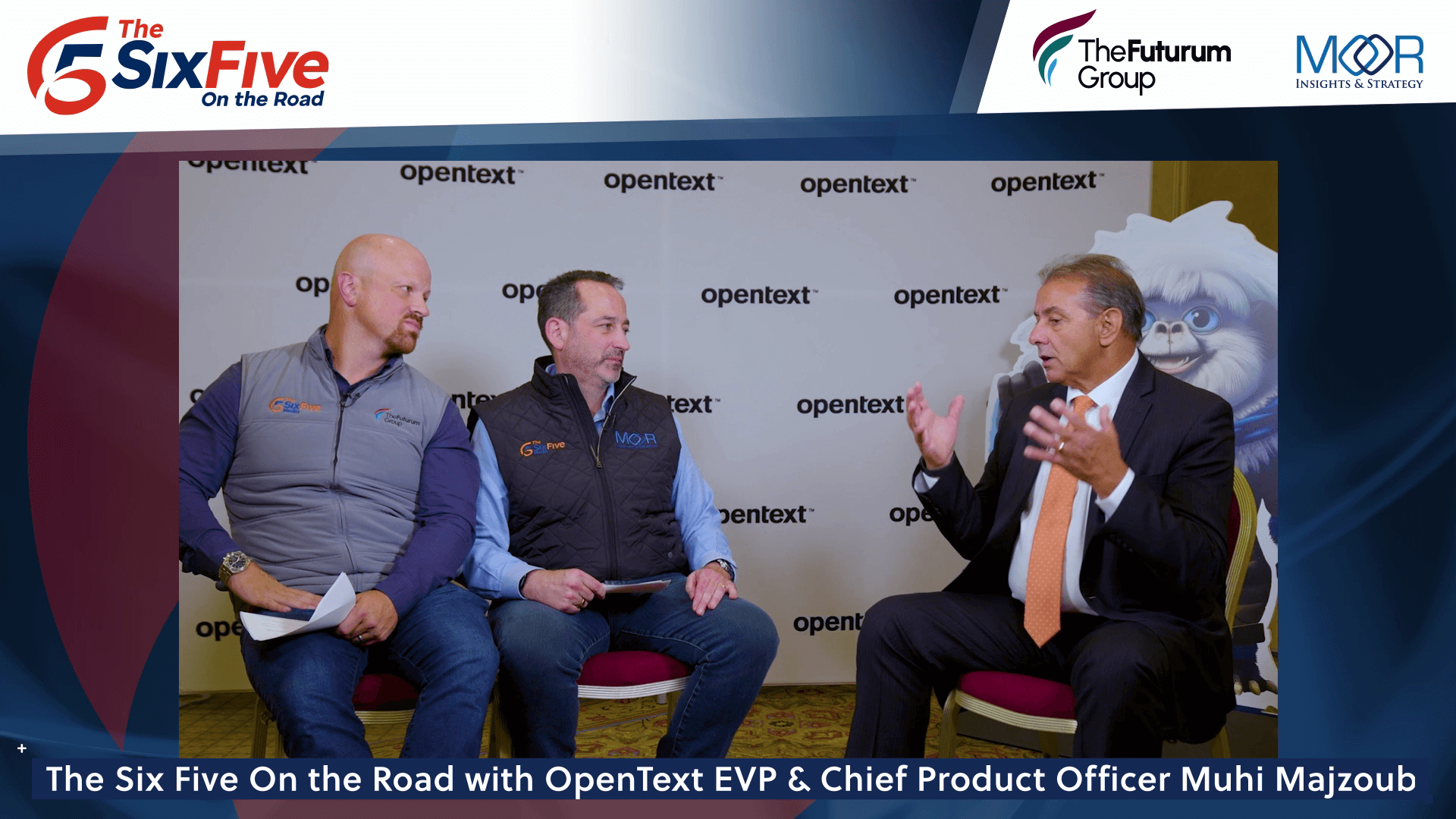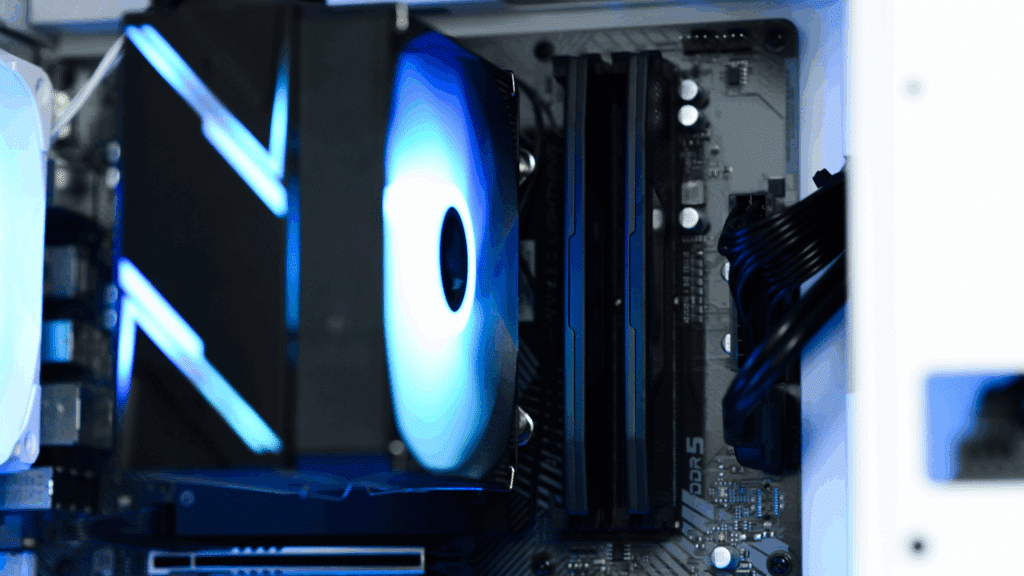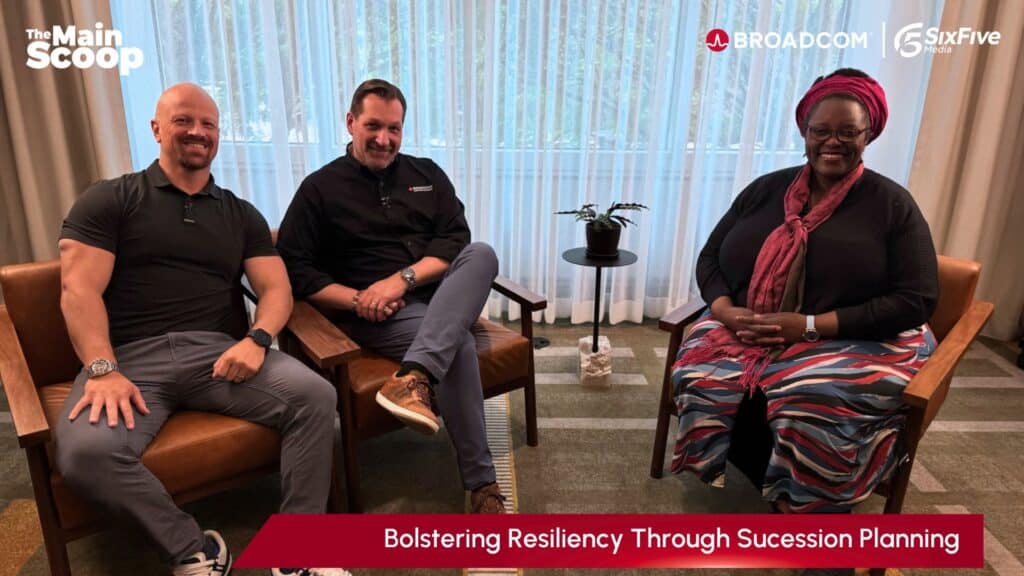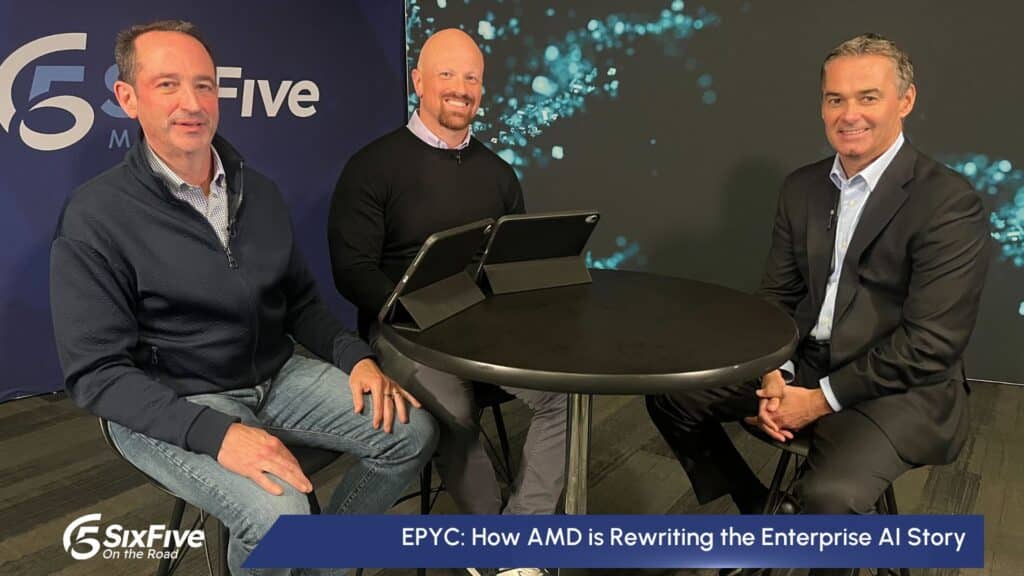On this episode of The Six Five – On The Road, hosts Daniel Newman and Patrick Moorhead welcome OpenText’s Muhi Majzoub, Executive Vice President and Chief Product Officer, for a conversation on how Information Management has evolved and how the company is innovating with AI and OpenText Aviator during OpenText World 2023.
Their discussion covers:
- Opentext’s brocaded mission following the MicroFocus acquisition
- How OpenText approaches innovation when driving their product roadmap
- Why integration is so important to innovating
- Why OpenText Aviator is unique in its approach to AI
- The key value drivers OpenText is delivering as OpenText Aviator rolls out
Be sure to subscribe to The Six Five Webcast, so you never miss an episode.
Watch the video here:
Or listen to the audio here:
Disclaimer: The Six Five webcast is for information and entertainment purposes only. Over the course of this webcast, we may talk about companies that are publicly traded, and we may even reference that fact and their equity share price, but please do not take anything that we say as a recommendation about what you should do with your investment dollars. We are not investment advisors, and we ask that you do not treat us as such.
Transcript:
Patrick Moorhead: The Six Five is live and on the road here in Las Vegas, at OpenText World 2023. Daniel, I love events. But you know the events I love the most are the ones where we’re talking AI, and also the ones that-
Daniel Newman: When you’re here with me?
Patrick Moorhead: Well, yes. But also the ones that, I don’t know, make us look smart. Like when you and I were talking all the time about having your data estate and your information estate in line before you can do anything useful with generative AI. And imagine that, here we are at OpenText world.
Daniel Newman: Yeah, just when you think there may not be a solution for all the solutions, you run into a solution that might be the solution for all the solutions. You got that?
Patrick Moorhead: Yeah. Can you say that three times fast?
Daniel Newman: Peter Piper picked a… Okay. All right. No. But seriously, it’s been a really good couple of days. And as analysts, we spend a lot of time trying to understand what all the different companies across the tech landscape are doing. And when you’re a company that focuses on B2B enterprise, you really have to consider right now what these enterprises are up against.
I heard you asked a 17-part question yesterday and you were really focused on the conversations that you and I have with these CIOs and CTOs. And the truth is that they all have solutions being put in front of them. And when AI is done in any one of those solutions, they’re pretty comfortable with how that works. But then all of a sudden, when they’re looking across all the data in their estate and they’re trying to figure out how to manage that information and use AI, they become more confused. And I think some of the answers were revealed here, at least some of the potential answers.
Patrick Moorhead: They were. And at the end of the day, when it comes down to those product and services, it’s Muhi, Chief Product Officer for OpenText. Welcome to The Six Five.
Muhi Majzoub: Thank You. Thanks so much for having me.
Patrick Moorhead: Absolutely. And I mean, you have a massive job trying to coordinate all of these different products and then having to put this AI layer on top of it. So congratulations on the big launch day. Having been an ex-product guy, I do know that it doesn’t stop at launch. In fact, some things are just beginning. But I did want to say congratulations.
Muhi Majzoub: Thank you so much. Thank you.
Daniel Newman: So you’ve had a big year. You’ve doubled the size of the company, made an acquisition, Micro Focus. I’d love to start there.
Muhi Majzoub: Okay.
Daniel Newman: Talk a little bit about how such a large deal, with all that’s going on across the data information landscape, has evolved, changed, shifted the ethos of Micro Focus.
Muhi Majzoub: Yeah. That’s a great question. Keeping the customer centricity that OpenText is famous for is very important for us. From day one, when we announced the intent to acquire Micro Focus, we really looked at how best our customers can benefit from and started putting the plan. On January 31st, when the acquisition was complete, bringing the employees together from the combined company and communicating a message that says, “Customer is first. Value in everything we do. It doesn’t matter what department you’re in, marketing, R&D. At the end, everything we do has to bring value to a customer or to their users,” it allowed our team to focus.
The second point is bringing our portfolios together. One of the best thing that happened for OpenText is there was very little overlap. OpenText, before Micro Focus, had no DevOps cloud. No competition internally at OpenText. It was clear, keep it focused on customer value. OpenText had no Idol platform for AI, had no Vertica database for columnar trillion rows, as Mark highlighted in his keynote. Again, it was very easy to marry that with our Magellan product, to give Vertica and Idol the studio to develop dashboards and predictive intelligence. So those things really helped us in bringing the teams together very quickly. And then it was a matter of sitting in a room with our CEO for three days, and I remember it was a cold day in Provo, Utah. We sat in the Micro Focus headquarters in the US, and we had a three-day offsite. And out of that offsite came a clear set of priorities, many of which you saw on stage today. Some you will see on stage in my keynote tomorrow.
Patrick Moorhead: I appreciate that. It was a great explanation. Kind of an inside, I’ve never heard the inside story of that. As I started off, doing products is hard and not only is it integrating companies that have been acquired, there’s organic innovation, there’s partner innovation, that you bring in. Having such a multi-variate and broad product line, I always like to say it’s easier to say yes than no to things when you have to make the call on products. Can you boil down what your product strategy is, given you have to serve so many different types of constituents out there?
Muhi Majzoub: Yes. It really starts with we are the leader in information management. So everything we do have to tie, one way or another, back to information. If you look at every one of the acquisition, I could tell you, 11 and a half years ago when I interviewed for the job with Mark over a breakfast table, he drew a picture of EIM. At that time, EIM, Enterprise Information Management, was not even mentioned in the industry, in 2012. He drew his vision of how he hoped to expand into the different areas of information. If you look at the historical acquisition, GXS brought to us supply chain. Supply chain is all about document. Every transaction, 22 plus billion transaction flows securely through our network every 12 months. Fax, Digital Fax, another acquisition. Security became important. We are to secure and govern that information. Then the acquisition of Actuate came. Then more security acquisition. Then IOT with Covisint, out of Michigan, which was very big. Covisint used to be the main supplier of the OnStar system for GM. All of that has been really putting the information management puzzle together for Mark and completing the vision he has. So Micro Focus brought to us application modernization with our AMC business unit, and moving off the mainframe onto PostgreSQL, much lower cost, open source and in a hyperscaler of choice. It could be Amazon, it could be Google, it could be Azure, it could be Oracle Cloud, any. We partner with all of them.
Micro Focus brought to us DevOps, a new set of information, and Micro Focus brought to us service management, a very important set of information, with asset management, universal CMDB, service desk and service management, known for network operation management, which can easily now integrate into our security offering to provide you better detection and response capability in the overall network footprint that you have. So all of that is really completing that information management, and then modernizing that information and that portfolio of product. Three years ago, and Mark mentioned that in his keynote today, we set in a different form meeting where we discuss, and we committed to Mark, that everything we develop will start with an API and will be publicly available, documented, to allow partners and customers to extend the solution. If they’re in Life Sciences and they need to build a new application, they can build it and still store the content in Documentum, or still store the content in Core Content or other platforms.
Daniel Newman: Yeah, it’s powerful and I like the whole part about a thousand LLMs or a thousand models. There’s going to be a model and maybe they won’t all be large, by the way. Some will be smaller and some will be more vertical and some will be more horizontal for language and image, but we’ll have many. And so, I did like that. And you also just alluded to API. API and integration has been a cornerstone of the conversations that we’ve been having here at OpenText World. You seem to be very focused on it. To me, I don’t see how you live without it. But talk a little bit about how you see the criticality and the importance of integrations in terms of really helping Aviator and helping OpenText grow. It’s next double, you know, in both inorganic and of course organic growth.
Muhi Majzoub: Another great question. APIs go side by side with an advanced workflow service. For us, some of the basics and the foundation we laid is we want information to be as much as possible centralized. Take core content, for example. Our APIs are leveraged by four or five different product, bringing the data into one place, bringing the workflow and the automation and the rules into one place. Where now, as you put an LLM and integrate, you have a much bigger set of data. You have the ability to get more trusted and less hallucination from the environment or from the model. And you have a wider set of test data to create analysis and make decisions off of. And that’s another point of Mark’s vision that we have talked about for many years. And a lot of it is coming live at this event this week, is the ability to now wrap our different business cloud with specific Aviators that could target a use case.
If you are a customer that only need the Aviator for supply chain to do canonical mapping, I don’t want to sell you the Global Search Aviator. I want to sell you, and in two weeks and you heard Mark made that commitment on stage, $350,000, we will commit in two weeks to get you up and running. That’s why you see those targeted use cases. We want our customers to recognize value in two weeks at a very minimal cost, and we’re making that commitment. This allow us to then learn from the customer experiences and decide how we advance our IOT and search, and other global Aviators through connectors to touch more data sets.
Patrick Moorhead: I love it. My company and myself, we’ve researched probably 250 different AI solutions, crossing IaaS, PaaS, and SaaS, all the way from consumer to hardcore enterprise, large enterprise. And I love the starter kit that you put up there, right? It’s one thing to be a starter for, “Hey, I’ve got all my data already in this SaaS environment and let’s just flip the switch to do something different.” But literally, the offering is a grounds up million documents and I thought that was very impressive. The other part of researching all these different solutions is sometimes differentiation is hard to distinguish. Okay? And I’m curious, if you could turn up the contrast ratio on Aviator, how is Aviator different from other types of enterprise B2B types of solutions related to AI?
Muhi Majzoub: I think the one differentiator that I see in our business Aviators is they’re only targeting our cloud, our data sets. I believe we are the expert in content cloud. We know content better than any other company. We have the privilege of serving 20, 30,000 of the largest enterprises in government. We understand the lifecycle of content from however you get it, an email, like customers, like the Department of Interior moving 120 million email per month into our platform. We understand if you get the content in fax, and you have to do capture and screen recognition. We understand that. Targeting our Aviators to our expertise, we believe could get you the best data return in decision-making and in analysis. Marrying that with our Vertica, Magellan and Idol platform allow us to then give you predictive intelligence. As you build historical data, I could give you better and better predictive intelligence.
Daniel Newman: So you’re focused on value, you’ve said that a few times throughout this presentation –
Muhi Majzoub: Oh, yeah.
Daniel Newman: … and I appreciate that. You’ve simplified an offering, and you’re giving people the keys and say, “Million documents, 350K, we’ll get you started, we’ll get you up, we’ll get you running.” Giving people a real compass.
Muhi Majzoub: Yeah.
Daniel Newman: Aviation, navigation, compass. Let’s just keep with the theme here. Let’s keep going. But value is measured in different ways. It’s not only monetary and spend in time, but those are certain metrics. As you continue to build the Aviator, the business Aviators, the technology Aviators, and you expand upon this platform, how do you envision being able to help your customers derive the value of partnering with OpenText and continuing to build on the Aviator platform?
Muhi Majzoub: Yeah, a hundred percent agree. Value is not only dollars and dollar saving. And as Mark highlighted in his keynote, the value can go up, depending if a customer says, “I want 10 million document or a hundred million document.” That value and the cost of storage go up. The dollar is not everything we look at. We look in the value we provide. If our Aviator could provide a company of a thousand employee 1% of productivity improvement, that’s like getting 10 people free now doing extra innovation for whatever your company is doing. What does that mean to me? Because, guess what, I’m going to be the first customer of our DevOps Aviator. I have 8,300 engineers in 30 plus countries. If I could gain 1% productivity improvement, that’s like having 83 engineers are building new Aviators for me without going for extra budget. So it’s not only dollar. We look for efficiency, we look for productivity, we look for speed of getting answers.
If I can now take that to, we have 130,000 customers that we have the privilege of serving, those customers have a hundred million users that touch one or multiple of our products. If each one of these customer can gain a 1% productivity improvement, because I’m not making them wait on a support phone line, and my Aviator, my Service Management Aviator answers the question, that’s really, really good. If my DevOps Aviator can do my test cases, which we will demonstrate on stage tomorrow in my keynote, that’s wonderful because now I can upskill my QA engineers to become coding engineers, building some of these. So the benefit comes in multiple, multiple ways. And from industry to industry, the benefit changes.
Patrick Moorhead: I love that example of 8,300 engineers, 1%. I love that. I haven’t heard it as succinct as that, but that’s kind of where the rubber meets the road for any business.
Daniel Newman: It makes me think of probably two decades ago, there was a commercial from Xerox, a name we don’t hear much anymore. And it said, “We solved this problem and it saved a nickel.” And they go, “It saves a nickel.” And it showed the IT versus, and say, “We do this many million transactions a day,” and we just say, you know. But that’s kind of the era we’re in right now.
Patrick Moorhead: Yes.
Daniel Newman: Is if we can find small, there’s this kind of economy of scale that it creates, and it’s almost can become exponential as it grows, both what we can be productivity-wise, but also what we can create efficiency-wise.
Muhi Majzoub: But OpenText will not stop there. Our Aviators, and I think Mark touched on that in his keynote today, we will have version two of our Aviators, and version three, and we’ll have new Aviators. Now, I’ll give you another example that for me will be very, very important. Supply chain. Again, 22 billion transaction flows through our network. Six and a half trillion dollar of commerce around the globe moves to our network every 12 months trailing. Picture, if I can now my Aviator can integrate through connectors into logistics, into weather pattern, and into financial system. And let me give you an example.
I’m Nestle, or I am any coffee company. I buy my coffee beans supply from Brazil, Columbia, Kona, Hawaii, and Java, Indonesia. Now, there is a typhoon in Indonesia, in South China Sea. My ships will be delayed six weeks. If that integration through the Aviator, and the Aviator can look at weather patterns and can look at things, and then the Aviator can look at financial and currency exchange and say, “I think your best bet is to buy it from Kona,” that becomes that AGI that Mark was referencing in his keynote. Where the machine is now not only helping you with the decision, but making that decision for you, and giving you the option to say, “No, I don’t want. I still want to buy it from Brazil.” But it at least gave you a decision. That’s, I think, the future, what Mark was referencing in his keynote earlier today.
Daniel Newman: It’s great power of systems and combinations. And Muhi, I think that’s a great way to end our conversation here. But it is so powerful how all this can tie together, to help companies deliver the results to their shareholders, to their employees, and of course to their customers. So thank you so much.
Muhi Majzoub: Agreed. Thank you so much.
Daniel Newman: All right, everybody, you heard it here. We are at OpenText 2023, in Las Vegas. It’s been a great time, Patrick Moorhead. We’ve talked to some of the most important executives and leaders here at OpenText, and we hope that you’ve enjoyed these conversations. Check them all out, if you have the chance. Hit that subscribe button if you haven’t already. And stay with us for all of our Six Five. But for now, Pat, we got to go. We’ll see you all soon.
Author Information
Daniel is the CEO of The Futurum Group. Living his life at the intersection of people and technology, Daniel works with the world’s largest technology brands exploring Digital Transformation and how it is influencing the enterprise.
From the leading edge of AI to global technology policy, Daniel makes the connections between business, people and tech that are required for companies to benefit most from their technology investments. Daniel is a top 5 globally ranked industry analyst and his ideas are regularly cited or shared in television appearances by CNBC, Bloomberg, Wall Street Journal and hundreds of other sites around the world.
A 7x Best-Selling Author including his most recent book “Human/Machine.” Daniel is also a Forbes and MarketWatch (Dow Jones) contributor.
An MBA and Former Graduate Adjunct Faculty, Daniel is an Austin Texas transplant after 40 years in Chicago. His speaking takes him around the world each year as he shares his vision of the role technology will play in our future.










